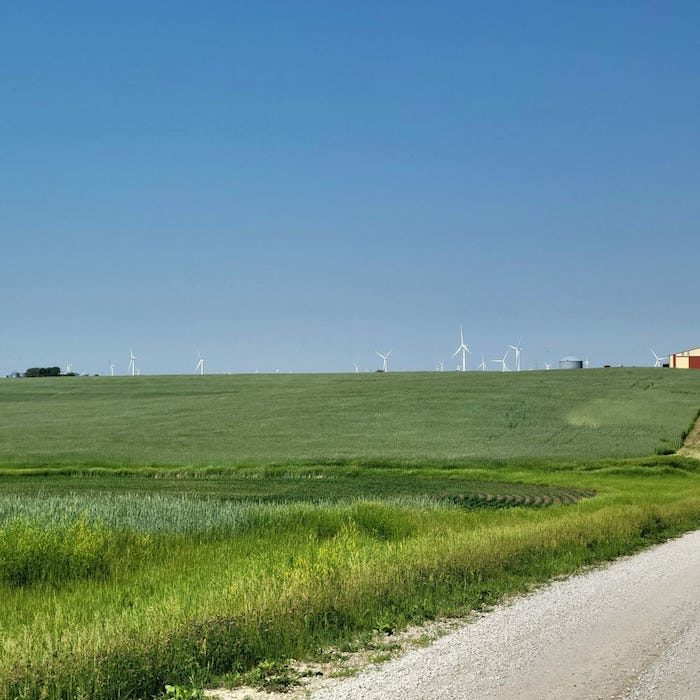Whether sourcing cover crop seed to plant for on-farm use or harvesting seed to sell, Chris Gaesser has over a decade of experience with cover crops and in the last few years began selling rye as cover crop seed. He shared tips for harvest and handling of cover crop seed in a small grains shared learning call in early June.After farming for many years with his parents, Chris now farms with his wife Shannon near Lenox in southwest Iowa. After years of cover cropping beginning in 2010, Chris and his family decided to grow their own seed. Forty to fifty acres provided enough seed for their farm, so they started selling the rest to neighbors. This promoted the use of cover crops in their area, and also offered a more affordable option for local farmers. Their business grew over time, and now Chris and Shannon raise about 350 acres of rye that yield up to 60 bu/ac in a good year.

Southwest Iowa farmer, business owner and cover crop advocate Chris Gaesser. Photo via PFI.
Key Tips for Growing Cover Crop Seed
When growing rye to harvest for seed, planting as early as possible in October is key to achieving 2-3 inches of growth before winter. Chris says that a drill or planter is more effective than broadcasting the seed. He plants approximately one bushel (roughly 60 pounds) per acre at a depth of about 2 inches.

In addition to corn and soybeans, Chris grows rye as cover crop seed and as grain for a local distillery. Photo via PFI.
Fall is also an ideal time to add manure or commercial fertilizer, which for Chris, typically is about 60 pounds of anhydrous nitrogen. “Once you get everything going in the spring, it’s pretty low maintenance. Rye especially suppresses weeds so we don’t spray any kind of herbicide on the crop in season,” Chris says.
Fungicide, however, may come in handy. Fusarium head blight, commonly known as scab, can be a major issue, particularly in humid areas. Infected rye heads become shriveled and chalky in appearance and are unsuitable to be used and sold. In the first year that Chris ran into an issue with scab, the rye only yielded about 20 bu. He recommends keeping a close eye out for bleaching when the rye starts to head in the spring and applying fungicide as needed. Additionally, anyone who does end up with some scab can adjust fan settings at harvest to blow more of the light, shriveled seed out behind the combine.Harvest, Cleaning and Storage
“One of the best pieces of advice that I’ve received for harvesting small grains is to wait a week from whenever you think it is ready. Don’t even look at it. Then come back in a week and that’s when it’s actually ready,” Chris says.When it finally is time to harvest, usually in mid-to-late July, he says that any regular row crop combine will do the job. Ideally, you’ll harvest the rye at a lower moisture content, typically before it starts to lay down.Once cut and in the bin, it is necessary to blow fans on the grain to cool it as quickly as possible to prevent it from spoiling and killing the germination potential. After 2-3 days, as soon as the grain is dry enough, Chris begins the cleaning process to remove straw and heads that tend to retain moisture. His modified John Deere 4400 combine uses the hopper system to dump the seed directly onto the sieves to be cleaned, and it is then augured directly into storage bags.

Chris uses a modified John Deere 4400 to clean the rye seed. Photo via PFI.
“As soon as we clean it, we send ours to the seed lab at Iowa State for germination tests every year. Especially if you’re in any kind of crop assistance programs, you’re going to have to do germination and purity tests.”Selling and Marketing Rye
Through their seed business, GX Agriculture, Chris and Shannon sell directly to customers, partner with local co-ops and feed stores and connect with customers via PFI’s Find Cover Crops app. In addition to selling rye as cover crop seed, Chris recently began selling rye to a distillery that reached out in hopes of sourcing rye locally. After selling 1,000 bushels to the distillery during a trial year, Chris was able to sell them 12,000 bushels last year. The biggest difference in handling these grains is using untreated equipment for the distillery. “I have a specific wagon that I use just for them. There’s never been treated seed in it. It’s all clean grain.”Crop Diversification
At present, Chris and Shannon’s rotations mostly involve corn and soybeans in addition to rye but they are looking to diversify their cover crop seed mix with triticale and oats in the coming years. In the future, they aim to try some lesser-known crops including perilla, a plant that can be harvested to produce oil similar to canola and lupini beans, a high-protein legume originally from the Mediterranean. Snap peas may also make an appearance on the Gaesser farm in the not-too-distant future.
Click here for more Industry News.








Post a comment
Report Abusive Comment